-
Welcome back Guest! Did you know you can mentor other members here at H-M? If not, please check out our Relaunch of Hobby Machinist Mentoring Program!
You are using an out of date browser. It may not display this or other websites correctly.
You should upgrade or use an alternative browser.
You should upgrade or use an alternative browser.
Atlas 10F V42
- Thread starter timmeh
- Start date
- Joined
- Aug 23, 2014
- Messages
- 222
Edit at end of my last post, re. Roberts query about "anti backlash".
was the only way I could see that helped with reducing backlash.
Twisting the cross slide nut(flat blade screwdriver between nut and side of channel, applying very light pressure) in relation to the cross slide screw while tightening the mounting screw.http://www.hobby-machinist.com/attachments/img_20170819_212317-jpg.240618/
I'll take a shot without the cross slide in place to clarify
- Joined
- Dec 25, 2011
- Messages
- 10,552
OK. When I saw the photo with the screw driver stuck up under the back of the cross slide, I assumed that you were showing tightening the wiper retainer screws. I would probably use a chisel. and show the round head screw being tightened. You're right. I haven't seen that method mentioned before. I do have to mention that it will wear quicker doing that. A longer lived fix would be a new nut. But it would be a way to get a little more usage out of a warn nut.
- Joined
- Aug 23, 2014
- Messages
- 222
I can see now where it would appear confusing.
The cross slide nut could be turned either way to reduce backlash. Mine is rather bad(approx. .040" at the most worn area of the screw), now less than .010"(guessing by feel, not measured yet) after tilting nut in relation to the screw.
Set the nut at the worst worn area of the screw, tightened just enough that it will move as it is wound along the screw towards a less worn area. Stop short of the least worn area and nip it up. Much better than it was.
EDIT: Wear between nut and screw with nut set parallel to screw, at three points, equispaced along travel of cross slide from front to back is, .016", .022" and .018".
With nut set as described above, measurements are, .002", .004" and .003". This will likely deteriorate somewhat, I will endeavour to post results later.
Few of shots of what is happening in the earlier pictures, should be fine turning/tilting either way, i.e. left or right. Felt and keeper goes on afterwards.
Then I have one for the recycling fanatics, pic #4 is comprised of the top of an electric kettle, parts of an old sprinkler and a bicycle component clamp(brakes or derailler, can't remember). Bit of panel beating, bit of bending, no machining of any sort.
Screen on topside of chip tray is a sales sample of perforated plate scrounged from somewhere, may need some bending later.
Oil catcher is on it's way.
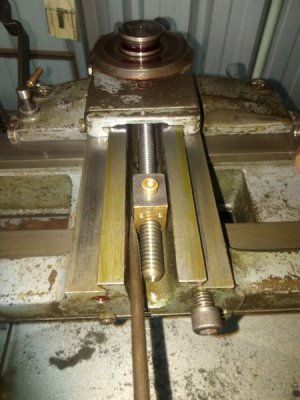
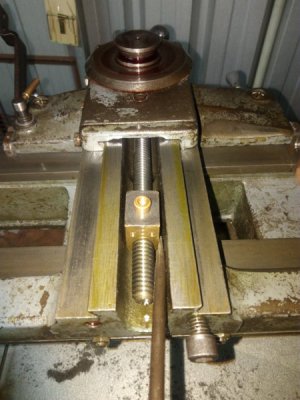
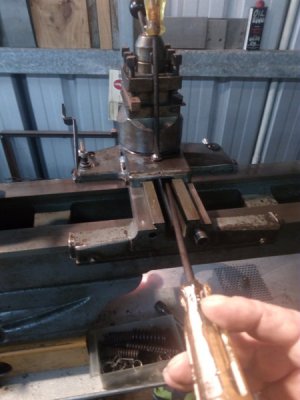
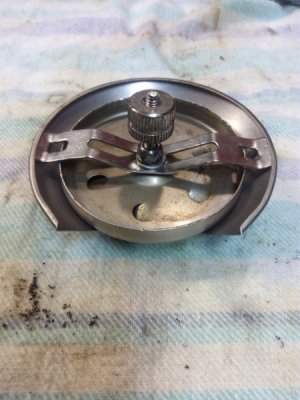
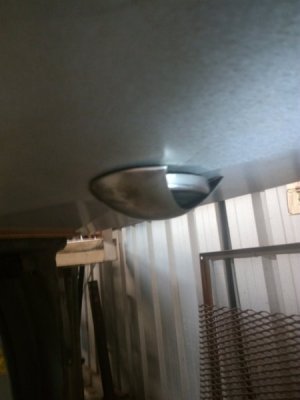
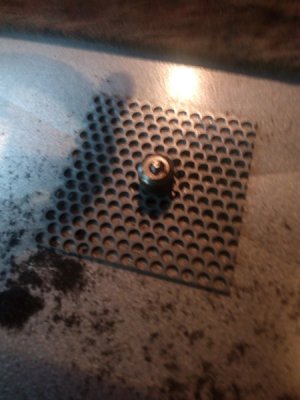
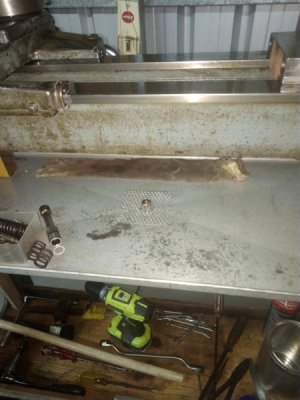
The cross slide nut could be turned either way to reduce backlash. Mine is rather bad(approx. .040" at the most worn area of the screw), now less than .010"(guessing by feel, not measured yet) after tilting nut in relation to the screw.
Set the nut at the worst worn area of the screw, tightened just enough that it will move as it is wound along the screw towards a less worn area. Stop short of the least worn area and nip it up. Much better than it was.
EDIT: Wear between nut and screw with nut set parallel to screw, at three points, equispaced along travel of cross slide from front to back is, .016", .022" and .018".
With nut set as described above, measurements are, .002", .004" and .003". This will likely deteriorate somewhat, I will endeavour to post results later.
Few of shots of what is happening in the earlier pictures, should be fine turning/tilting either way, i.e. left or right. Felt and keeper goes on afterwards.
Then I have one for the recycling fanatics, pic #4 is comprised of the top of an electric kettle, parts of an old sprinkler and a bicycle component clamp(brakes or derailler, can't remember). Bit of panel beating, bit of bending, no machining of any sort.
Screen on topside of chip tray is a sales sample of perforated plate scrounged from somewhere, may need some bending later.
Oil catcher is on it's way.







Last edited:
- Joined
- Aug 23, 2014
- Messages
- 222
http://www.hobby-machinist.com/attachments/image0505-jpg.239824/
Have uploaded a video of this pic to facebook. I can see it, hope it comes through, not good footage, shows all the gear in post #15 in action and under load as described.
EDIT: 24 hrs later and I can't see it even if I'm logged into facebook first. Worked just fine yesterday.
Works fine in facebook.
I'll have to try something else, bear with me.
Have uploaded a video of this pic to facebook. I can see it, hope it comes through, not good footage, shows all the gear in post #15 in action and under load as described.
EDIT: 24 hrs later and I can't see it even if I'm logged into facebook first. Worked just fine yesterday.
Works fine in facebook.
I'll have to try something else, bear with me.
Last edited:
- Joined
- Aug 23, 2014
- Messages
- 222
OK, all should be set on youtube now, posted two short vid's.
Search "Atlas full swing2" for the disc rotor and "10F V42 in action" for the remake of turning 3.5" 4140, 145 rpm, .070" DOC @ around .003" feed(lost video was 110 ish RPM, .050" DOC @ .005" feed).
Not ideal chip control, last time I had a go at higher feed the tool kept winding in by itself due to vibration. Still some vibration, probably due to running at near double recommended RPM.
EDIT: Just went downthashed to tidy up a little after last nights test thrashing on the atlas, turns out the last cut was .110" DOC. Now I'm impressed.
Search "Atlas full swing2" for the disc rotor and "10F V42 in action" for the remake of turning 3.5" 4140, 145 rpm, .070" DOC @ around .003" feed(lost video was 110 ish RPM, .050" DOC @ .005" feed).
Not ideal chip control, last time I had a go at higher feed the tool kept winding in by itself due to vibration. Still some vibration, probably due to running at near double recommended RPM.
EDIT: Just went downthashed to tidy up a little after last nights test thrashing on the atlas, turns out the last cut was .110" DOC. Now I'm impressed.
Last edited:
- Joined
- Aug 23, 2014
- Messages
- 222
Have done a fair bit of repair/modification to the Fwd/Rev gearbox in the time that I have owned this lathe, it had suffered quite a lot of distortion after the crash(I suspect a fairly major one by a previous owner) and was difficult to engage.
Pic 1 shows position of the crack at the left end.
Pic 2 shows shimming points that have been adjusted after repair and the left journal that was bent down and toward the viewer.
Pic 3 finished lower half journal I made from a piece of cast iron cut from parts of a scrap printing press. The marked point is approx. position where the tongue of the upper half journal was bent out to.
Used a heat gun to do a bit of heat/shrink manipulation, not heat it up and throw a wet rag over the hot spot, apply heat and gentle pressure, remove heat, keep pressure on while it cools. Patience is key, took several hours over a few days to get it right. Nothing broke.
All good now, engages easily, much quieter operation.
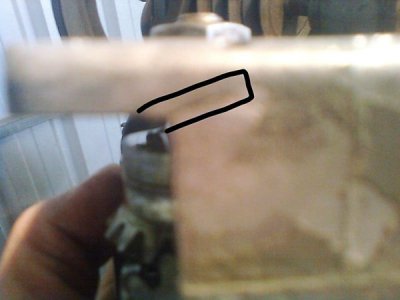
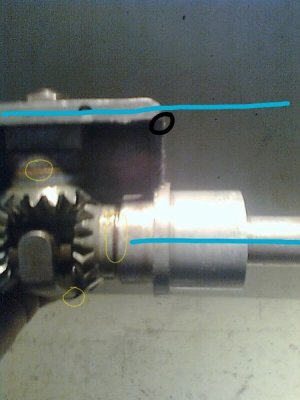
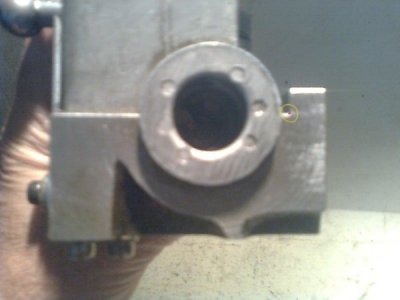
Pic 1 shows position of the crack at the left end.
Pic 2 shows shimming points that have been adjusted after repair and the left journal that was bent down and toward the viewer.
Pic 3 finished lower half journal I made from a piece of cast iron cut from parts of a scrap printing press. The marked point is approx. position where the tongue of the upper half journal was bent out to.
Used a heat gun to do a bit of heat/shrink manipulation, not heat it up and throw a wet rag over the hot spot, apply heat and gentle pressure, remove heat, keep pressure on while it cools. Patience is key, took several hours over a few days to get it right. Nothing broke.
All good now, engages easily, much quieter operation.



- Joined
- Feb 16, 2017
- Messages
- 136
Tlm,
Thanks for the tip about cocking the cross slide nut sideways. I did it today and
it drastically reduced the backlash in my cross slide. As was already stated, I understand the wear isses. This will be a stop-gap until i replace the screw and nut.
Thanks for the tip about cocking the cross slide nut sideways. I did it today and
it drastically reduced the backlash in my cross slide. As was already stated, I understand the wear isses. This will be a stop-gap until i replace the screw and nut.
- Joined
- Dec 25, 2011
- Messages
- 10,552
Tim,
I get better cuts with higher feed rate and smaller DOC. Also less vibration. The only time that I can recall ever having a "winding in" problem was trying to use a form tool to cut a 1.4" radius on some 1" dia. copper alloy contacts using a form tool made from a 1/2" square brazed carbide. I finally had to lock the cross slide and make the cut with the compound slide with the gib over-tightened. If you're having the problem of the cross slide winding in due to vibration, try locking the cross slide during the cutting pass. Remove either the3rd gib screw and substitute the T-handle lock screw from the milling attachment. Be advised that the "T" will hit the right rear saddle wing if you run the cross slide too far to the rear, unless the "T" is horizontal. Generally, that will not happen during turning. But it can be a problem while milling, or while running the cross feed nut off of the end of the screw.
I get better cuts with higher feed rate and smaller DOC. Also less vibration. The only time that I can recall ever having a "winding in" problem was trying to use a form tool to cut a 1.4" radius on some 1" dia. copper alloy contacts using a form tool made from a 1/2" square brazed carbide. I finally had to lock the cross slide and make the cut with the compound slide with the gib over-tightened. If you're having the problem of the cross slide winding in due to vibration, try locking the cross slide during the cutting pass. Remove either the3rd gib screw and substitute the T-handle lock screw from the milling attachment. Be advised that the "T" will hit the right rear saddle wing if you run the cross slide too far to the rear, unless the "T" is horizontal. Generally, that will not happen during turning. But it can be a problem while milling, or while running the cross feed nut off of the end of the screw.
